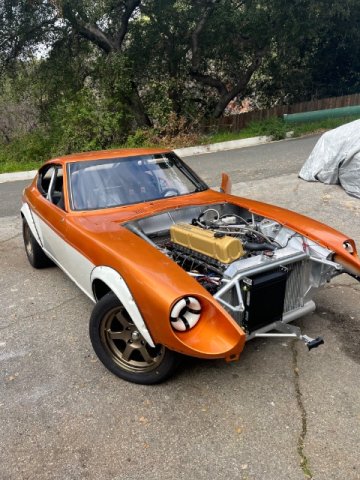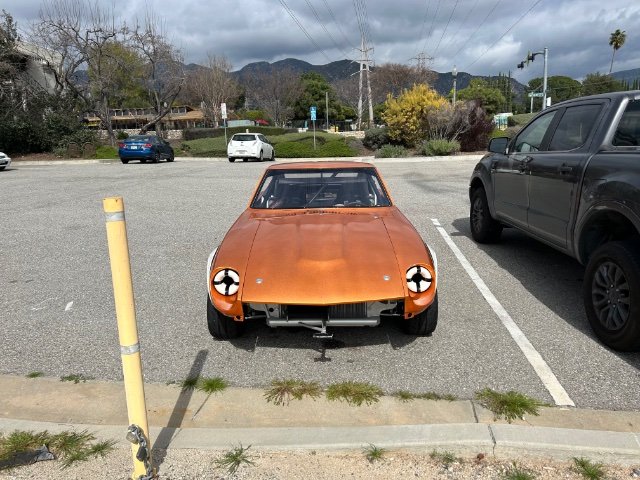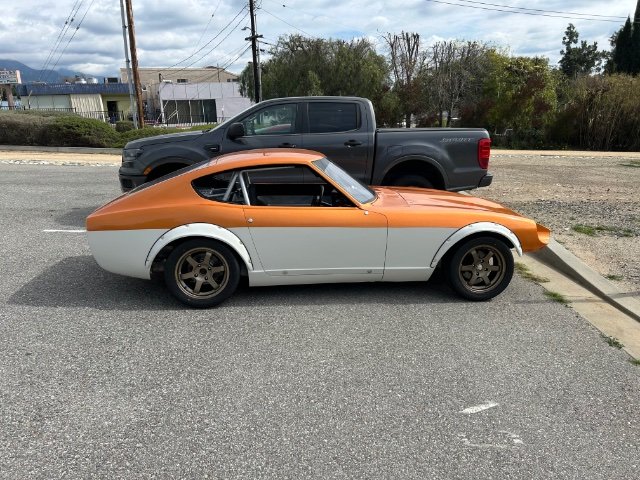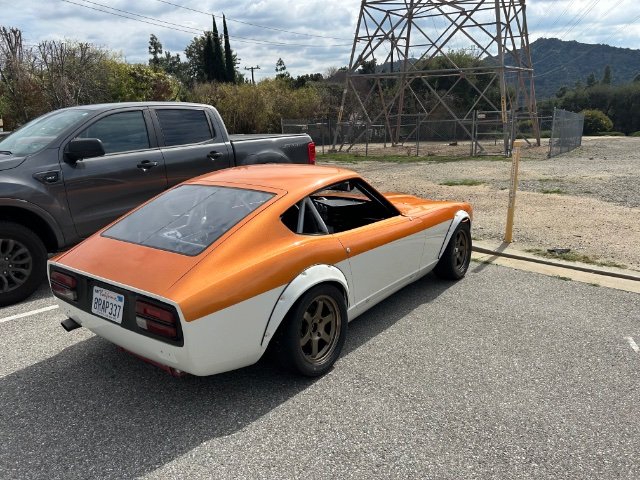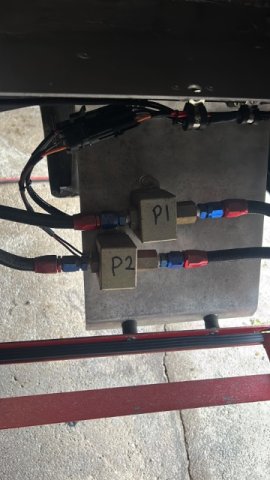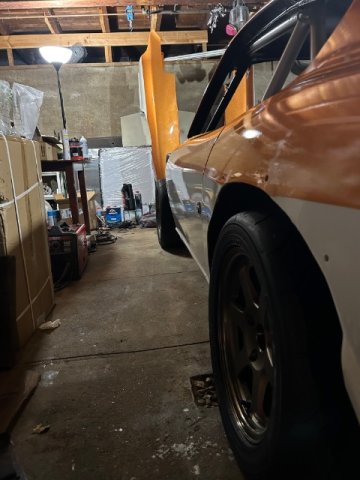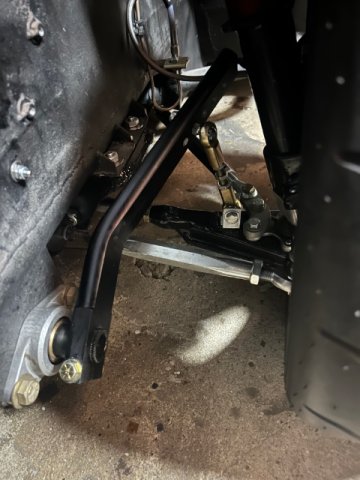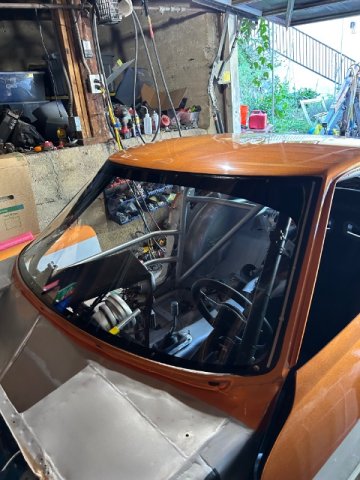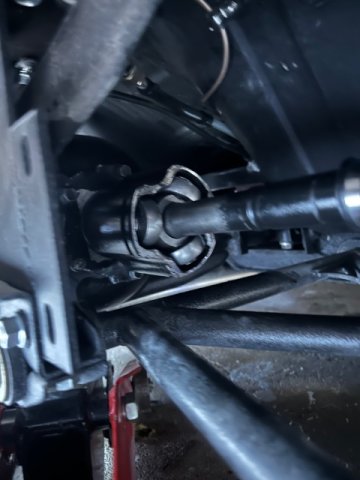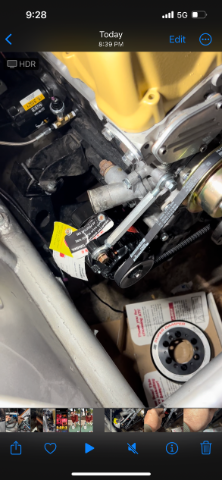
AydinZ71
Members-
Posts
1073 -
Joined
-
Last visited
-
Days Won
27
Content Type
Profiles
Forums
Blogs
Events
Gallery
Downloads
Store
Everything posted by AydinZ71
-
240z SCCA vintage race car, restoration
AydinZ71 replied to AydinZ71's topic in S30 Series - 240z, 260z, 280z
@tube80z thanks Cary! Yep, I just installed a new fire bottle so all my car-related equipment is up to date. It’s just the driver gear I have left. Is there any reason I shouldn’t consider used for the helmet, suit, etc? -
240z SCCA vintage race car, restoration
AydinZ71 replied to AydinZ71's topic in S30 Series - 240z, 260z, 280z
@calZ Bummer Well heck, there is a scenario where flying-out to an outlet would be worthwhile. I need literally everything for driver safety gear, so it’s going to be a big spend however I slice it. My lesson learned over the years has been to start cheap and used if possible, until I get an appreciation for where to spend the $$, and where it doesn’t matter. -
240z SCCA vintage race car, restoration
AydinZ71 replied to AydinZ71's topic in S30 Series - 240z, 260z, 280z
Well, the big day came this past weekend. Car was road-worthy. Took it for a spin up my local mountain road, and put a massive smile on my face. Front air dam is next, then more suspension adjustment. Need to look into driver safety gear, and would be inclined to source used if possible. Although not really sure if that’s a practical solution. I missed my local annual SCCA driver school, so I’m kind of ****** until next January. Gives me a year of track-days and more time to develop the car I suppose. I may drop-In the 3.1L race motor I developed, since I have no need to confirm with class rules for at least a year. IMG_3781.mov IMG_3782.mov -
Looking for Help Sourcing TE37Vs
AydinZ71 replied to Strat0206's topic in Brakes, Wheels, Suspension and Chassis
It took me three years of looking at eBay for the set I needed to pop-up. 15X7” 0-offset, 4X114. They are NLA in that size at the moment. Got them for $2250 shipped. They were used for in excellent condition. -
240z SCCA vintage race car, restoration
AydinZ71 replied to AydinZ71's topic in S30 Series - 240z, 260z, 280z
@jhm thanks John!! Yeah I fabricated the sway bar mounts over a year ago, before paint, so I’m glad to see they work as intended. They are tight! I mean… really tight 😂 zero play, and it responds immediately. Far cry from OEM in hindsight. yeah I got the set for $500 locally! I can’t afford all this race car stuff without getting it at steep used discounts. Now I need a set of wheel levelers, as my garage (aka, 1920’s cellar) is wildly uneven. I’ll get the fender and hood on, so I can take some more shots of it moving around. Really happy with the way it handles so far. I did string alignment, but I need to re-do it on a flat, level surface. -
240z SCCA vintage race car, restoration
AydinZ71 replied to AydinZ71's topic in S30 Series - 240z, 260z, 280z
Thanks man! Almost four years now, and an enormous amount of over-thinking on details. I’m glad 9/10th of my “ideas” worked! -
240z SCCA vintage race car, restoration
AydinZ71 replied to AydinZ71's topic in S30 Series - 240z, 260z, 280z
Just a photo dump update. Car is on the road. Just need a few loose ends and I’ll be off to a test & tune track day. - added too much rear track in my rear. Too much for the Datsun restomod STI CV shafts. Had a spacer made by send-cut-send w/ a centering pilot. Works great so far. Will eventually get longer length CV inner shaft made. - fuel cell bladder was giving off way too much fumes to be normal. Replaced the bladder…. Gosh they are expensive! - got a set of used Longacre scales for a great deal! - rigged up a way for the valve cover breather and block breather to dump into a single catch can. Can is ventilated back through the air cleaner of my forward SU. Floats are also vented to the air cleaner. - polycarb windshield is on. Works great, and almost looks like glass. I need some tips on keeping it scratch-free. - new fire bottle on the way (mine expired years ago). SFI cert 5-pt harness is in. Still need some time to adapt Greg Ira’s race seat into the car, but for now the cheap used corbeau seats are working. - IMG_2376.mov -
IMSA GTU vintage racer build
AydinZ71 replied to clarkspeed's topic in S30 Series - 240z, 260z, 280z
Nice work Clark! Getting close! You are where I was around 5mo ago. Glad to hear your health is improving as well. I have high cholesterol so your experience was personal to me. what do you plan to do for the rear axle shafts? Custom length CV’s? I learned the hard way that CV’s have less travel than our OEM half-shafts. I pulled the spider gear out the diff-side collar over the weekend love me some Z31 (your car show post). It’s a shame it’s a dog in the track on account of the trailing arm rear suspension, weight, well… I can go on. But I absolutely loved mine, and it was my first car (85’ NA). Great street car, and under appreciated in my mind. -
Silvermine Motorsports -Ford 8.8 Rear End Conversion for 240z
AydinZ71 replied to toolman's topic in Drivetrain
The one from invincible extremes is the only one I know that is actually drag-strip tested without any known failures. Seen pictures of folks breaking parts from T3, although to be fair, they were making monster torque with boosted LS motors. Everything has a limit. -
240z SCCA vintage race car, restoration
AydinZ71 replied to AydinZ71's topic in S30 Series - 240z, 260z, 280z
First start up since starting the restoration. Kind of shocked she started right up on the first go. Was expecting something on the MegaJolt to need fixing, but it worked great. Went with Magnacor wires, but they made a mistake and did not fit them up with the right coil boots. Being remade and shipped, so I am using 05’ ford explorer NGK wires for now. Went with a “7” heat NGK plug on account of the 10:1 CR. It’s raining this weekend, but just need to dial-in some crude alignment and she will be road worthy IMG_2339.mov -
240z SCCA vintage race car, restoration
AydinZ71 replied to AydinZ71's topic in S30 Series - 240z, 260z, 280z
Hi all! I’m about a week or so away from start-up on the race car. Running a street-able cam at the moment (280dur, .460 lift) with the SU’s and SM needles. Static CR us 10:1. I have the MegaJolt crank-fire ignition, and I’m looking to load my first ignition map. Does anyone else run programmable ignition and have a map they can share? Screen shots would be great. I’m looking for advance based on RPM, and advance/retard from throttle position. I have searched the forum and found some screen shots, but they are very old. Also have not seen any data on TPS ignition influence. thanks in advance! -
Hi! I thought the clutched STI 3.9:1 LSD was available in the years 05-07’? Meh, minor detail. Was just curious if my recollection is wrong. Maybe that’s just the US models. keep in mind, now that you have your LSD carrier and stub axles, you can swap out the carrier to different r180 with whatever ring/pinion ratio you like. Sounds like you will be happy with the 3.9, so you’re all set. Just nice to know you have options. I swapped my helical STI LSD carrier into a 4.11 for track purposes. im not sure how often the clutched carriers need to be inspected or the clutches replaced, but not a bad idea to do it now before you seal her back up. I have never had a clutched LSD myself, but I know the competitive S30 road racers prefer it.
-
@jeffer949 I agree ☝️ you are driving light-to-light, not racing. Save your money for the tune, reliable fuel system, injectors, engine management, etc. you CAN go cheap on those internal engine components as OEM goes a long way. Just don’t cut corners on the machining (ring gaps, bore, hone, tolerances, etc.), and especially not in the tune.
-
I have not looked at the whole Kameari line of pistons in a while. I just know they are rather affordable at the moment with the exchange rate, and they offer both cast and forged racing pistons. I thought they had an OEM pin height, but I could be wrong. Check out RHD Japan, and search through their offerings. They had what I was looking for in stock, which was much better than CP who flat out would not return my e-mails or calls. Yes, the Kameari forged race pistons have a 4mm. Shorter pin height (going off memory) which would pair with the 137.5mm rods they also sell, for a V07 crank. I have this setup in a 3.1L at the moment, which will be NA. I wouldn’t recommend it for a turbo. It’s meant to be a lightweight rotating assembly for reliable high revs. And lower parasitic loss. if you go with Ross, JB, CP, eagle etc. you will be happy. They are all decent quality IMO. Go with whomever can make or stock what specific size you need within your budget. Nominal differences in mass will not matter for a turbo setup anyways. Your focus should reliability and survivability. just doing some math, a P90 (you said it’s an L28et) with flat top pistons will yield you ~8.7:1 w/ oem style 1mm crushed gasket. A little high for my taste. You have the option to go with a 2mm (from cometic for example), or go with dished custom pistons and shave the head to your liking. Lots of ways to go about it. I have no idea what your goals are, but if you want to keep it budget: buy a set of new (assuming that’s an option) or used OEM pistons matching your next bore dia. with new rings and run with that. You don’t need forged pistons for 300+ Ft-lbs of torque, but you will need a reliable conservative tune. OEM was something like 7.4:1 CR which was super conservative. Bottom line: do NOT attempt to drive with a crude, ballpark tune and OEM cast pistons. Take it to a reputable shop that can reliably identify your engines knock limits. Super common that you will not hear light knocking under boost, and will be in the same place again in several months.
-
A Excellent Video on A Complete Body Restoration of a 240Z car
AydinZ71 replied to toolman's topic in Body Kits & Paint
I have done a complete chassis resto. Took me 3 years… oooof. Let us know if you have any questions. #1 take away: it is more expensive, more time consuming, and more tedious than one would possibly imagine, especially if you are stiffening the chassis and replacing rust along the way. absolutely, positively 100% worth the time and effort to find a body you can build from that does not require a full bare-metal resto. You will never get your time and money back, haha. Maybe for a rare European, but not a Z. Also, as popular as the rotisserie is, it can be done without. You wire-wheel the underside on your back wearing proper PPE, and use a brush to apply the epoxy sealer. -
Try cleaning the pistons and look closely for cracks. Very, very good chance there is more damage than just the missing skirt section. Often happens when a boosted engine detonates (knock). Were you able to remove all the rings OK?if you see skirt damage, the ring lands are often cracked or some rings are seized in the groove. Check your cylinder walls. It’s possible you just need a new piston kit, and everything else may be salvageable. My guess is this was the #5 or #6 piston. Machine shop can tell you if your block needs to bore or only re-hone. If you do re-bore, remove as little material as possible (pistons are available in 0.5mm increments, at least from kameari). Folks have shown cylinder wall rigidity to be more important with boost than a slight bump in displacement. Thin walls lead to plastic deformation = blow-by. Ross forged pistons are fine. I’d take an opportunity to opt for a CR closer to 8.0-8.2:1. Good balance between off-throttle response, lag, and room for boost. You won’t do well at 9:1 + boost on an L-series, although I see it often on an RB. Chamber just isn’t optimized well enough to avoid detonation, and you will be limited on boost. let them know it’s for a forced induction application so they design the ring lands appropriately. OEM rods are good to around 400ft-lbs in my experience, but you will likely struggle with heat management and detonation up there.
-
240z SCCA vintage race car, restoration
AydinZ71 replied to AydinZ71's topic in S30 Series - 240z, 260z, 280z
@Derek thanks! I’ll look into Magnacore now! PS: big fab of your AL casting work. -
240z SCCA vintage race car, restoration
AydinZ71 replied to AydinZ71's topic in S30 Series - 240z, 260z, 280z
Hi all! Question: anyone have a source for high quality, custom length spark plug wires? I am using the MegaJolt ignition controller with crank fire and a EDIS 6 plug coil. Also, any tips and tricks to picking the right spark plugs? I am familiar with the OEM style NGK’s, buts it’s been 20 years since I picked a plug temp spec. Updates: 1) Denso 6lb alternator (Nissan 1-wire is 10lb) installed. Custom mount fabricated from steel angle, and McMaster rod ends to make a belt tensioning turnbuckle. 2) brake pressure switch installed and functional. 3) interior wiring complete and 50% of engine compartment wiring. 4) oil pan back on engine with oil temp sensor installed. 5) oil pressure switch, and remote oil pressure transducer installed. engine turned over until I have oil leaving cylinder head cam oiler holes. IMG_2231.mov -
16psi T3 super 60 compressor trim ~300ft-lbs torque. I assume you are just going light to light. If you are not sustaining boost and high load for long periods of time, I don’t think these little details are going to matter much. If you are going to be using it for drag or road racing, a $300 gasket isn’t a big deal, and you will be looking at many more upgrades to keep the engine alive including an oil cooler, baffled oil pan, etc. Also, there is a dude who used to frequent hybridZ (TonyD) and did some testing by blocking some of the coolant passageways at the gasket and allowing the extreme outer ones to carry the flow. He saw better temperature distribution across the cylinders, including the problematic #5 and #6. Basically, it’s not as intuitive as you may think. If you are going from light to light, coolant water is a very efficient heat sink and some minor blockage (assuming it’s vital to begin with) will be solved by exchanging heat with the remaining flowing coolant. I’d just send it. get an oil temp gauge and put a sensor in your oil pan or oil pickup. Oil temp is a much better gauge on how instantaneously hot your internal components are getting. Like I said, coolant is just a heat sink, while your oil is literally in contact with your critical surfaces.
-
I used the Felpro gasket on my L28et for 20 years. If it wasn’t ideal, I couldn’t tell the difference.
-
240z SCCA vintage race car, restoration
AydinZ71 replied to AydinZ71's topic in S30 Series - 240z, 260z, 280z
Thanks Clark! Just need to weld-on my 1/8” NPT bung onto the OEM oil pan and I should be ready to finish assembling the L24. The 3.1L has Ben’s AZZCar oil pan, which already has nozzles I can use for oil temp. I think the L24 will be OK on track with the 3qt accusump. -
FWIW, I just bought a used cam oiler bar in useable condition for $50 plus shipping two weeks ago. Just posted a “wanted” ad on Facebook and had someone ship it to me in less than a week. Could give it a shot. Try the S30 classifieds for sale/wanted group. I also have one fabricated by Mike Yoes, but have not used it yet. That was $200 new.
-
240z SCCA vintage race car, restoration
AydinZ71 replied to AydinZ71's topic in S30 Series - 240z, 260z, 280z
SOLVED! bottom right hand corner of that picture is the lobe center. Trial and error, realized that’s what that was after measuring intake valve movement on #1 several times. Although the valve opening and closing on the card didn’t match what I was seeing in the dial gauge, i was able to scale the numbers. Went +0.05 and -0.05 from lobe center, split the difference, and ensured the middle was 110deg. When checking the valve open (@0.01) and close, what I was measuring scaled. Pretty confident now the valve timing is correct. I even back-tracked to make sure bottom end was still 0 at TDC. this is a brand new chain. Old one was so stretched, the tensioner was cocked upwards and no longer concentric. However, since it’s new I’m going to have to check the valve timing again after break-in (head was rebuilt). I’m sure il get some stretch out of it. -
@NewZed if one were to avoid using a surge tank in the engine bay, I agree. You would have to solve your slosh/starvation issues at the tank. Even a momentary vapor bubble pulled into your fuel line will cause a problem with EFI, if the ~40psi doesn’t cause it to collapse. SU’s, you would be OK to a point, since the fuel dumps into an atmospheric reservoir anyways (float chamber). I am a big fan of the quart surge tank though. S30 has a ton of space up front to choose from, but it would be a struggle to fit Z31+. That’s a heck of a lot of fuel to run-through, and the shape means you will use it all before you pull Vapor into your EFI pump. To be specific, this is my experience with the L28et street Z I have (@16psi). Have not raced yet… I’m just an Engineer that comes-off as a know-it-all, and humbly accept criticism as a result. I don’t mean to be condescending, but I recognize i can be. John and Ben are real racers though cars almost running! Should be hitting the track by Feb (thanks to my California mortgage payment). good luck to the OP! PS: same problem to consider with oil starvation, but it would take significantly more lateral G’s than what it takes to suck Vapor in your tank when <1/3 tank.
